
- •Explanation
- •1. Flash (the default location) 2. Tftp server 3. Rom (used if no other source is found)
- •Question 3
- •In a switched environment, what does the ieee 802.1q standard describe?
- •Question 8
- •Question 3
- •Vlan 3 is not yet configured on your switch. What happens if you set the switchport access vlan 3 command interface configuration mode?
- •Explanation
- •In the Frame Relay network, which ip addresses whould be assigned to the interfaces with point-to-point pvCs?
- •It has become necessary to configure an existing serial interface to accept a second Frame Relay virtual circuit. Which of the following are required to solve this? (Choose three)
- •If ip routing is enabled, which two commands set the gateway of last resort to the default gateway? (Choose two)
- •Question 8
- •Explanation
- •Explanation
- •If the startup-config file is missing or does not specify a location, it will check the following locations for the ios image:
- •Question 4
- •Explanation
- •Explanation
Vlan 3 is not yet configured on your switch. What happens if you set the switchport access vlan 3 command interface configuration mode?
A. The command is accepted and the respective VLAN is added to vlan.dat. B. The command is rejected. C. The command is accepted and you must configure the VLAN manually. D. The port turns amber.
Answer: A
Explanation
Even VLAN 3 is not yet configured on the switch, we can set the switchport access vlan 3 command without no problem and it also displays when we type the “show running-config” command.
Question 3
What are three advantages of VLANs? (Choose three)
A. VLANs establish broadcast domains in switched networks. B. VLANs utilize packet filtering to enhance network security. C. VLANs provide a method of conserving IP addresses in large networks. D. VLANs provide a low-latency internetworking alternative to routed networks. E. VLANs allow access to network services based on department, not physical location. F. VLANs can greatly simplify adding, moving, or changing hosts on the network.
Answer: A E F
Question 4
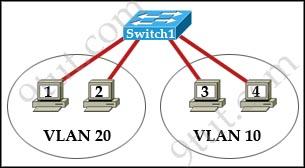
On corporate network, hosts on the same VLAN can communicate with each other, but they are unable to communicate with hosts on different VLANs. What is needed to allow communication between the VLANs?
A. a router with subinterfaces configured on the physical interface that is connected to the switch B. a router with an IP address on the physical interface connected to the switch C. a switch with an access link that is configured between the switches D. a switch with a trunk link that is configured between the switches
Answer: A
Question 5
Cisco Catalyst switches CAT1 and CAT2 have a connection between them using ports Fa0/13. An 802.1Q trunk is configured between the two switches. On CAT1, VLAN 10 is chosen as native, but on CAT2 the native VLAN is not specified. What will happen in this scenario?
A. 802.1Q giants frames could saturate the link. B. VLAN 10 on CAT1 and VLAN 1 on CAT2 will send untagged frames. C. A native VLAN mismatch error message will appear. D. VLAN 10 on CAT1 and VLAN 1 on CAT2 will send tagged frames.
Answer: C
Explanation
A “native VLAN mismatch” error will appear by CDP if there is a native VLAN mismatch on an 802.1Q link. “VLAN mismatch” can cause traffic from one vlan to leak into another vlan.
Question 6
Which of the following are benefits of VLANs? (Choose three)
A. They increase the size of collision domains. B. They allow logical grouping of users by function. C. They can enhance network security. D. They increase the size of broadcast domains while decreasing the number of collision domains. E. They increase the number of broadcast domains while decreasing the size of the broadcast domains. F. They simplify switch administration.
Answer: B C E
Explanation
When using VLAN the number and size of collision domains remain the same -> A is not correct.
VLANs allow to group users by function, not by location or geography -> B is correct.
VLANs help minimize the incorrect configuration of VLANs so it enhances the security of the network -> C is correct.
VLAN increases the size of broadcast domains but does not decrease the number of collision domains -> D is not correct.
VLANs increase the number of broadcast domains while decreasing the size of the broadcast domains which increase the utilization of the links. It is also a big advantage of VLAN -> E is correct.
VLANs are useful but they are more complex and need more administration -> F is not correct.
Question 7

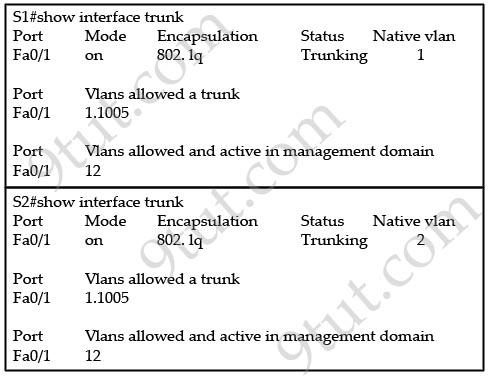
A frame from VLAN1 of switch S1 is sent to switch S2 where the frame received on VLAN2. What causes this behavior?
A. trunk mode mismatches B. vlans that do not correspond to a unique IP subnet C. native vlan mismatches D. allowing only vlan 2 on the destination.
Answer: C
Explanation
For 802.1q encapsulation, the native VLAN must matched at both side; otherwise the link will not work. In this case the native VLAN of S1 is 1 while the native VLAN of S2 is 2.
Question 8
Which statement about vlan operation on Cisco Catalyst switches is true?
A. when a packet is received from an 802.1Q trunk,the vlan id can be determined from the source MAC address table. B. unknown unicast frames are retransmitted only to the ports that belong to the same vlan. C. ports between switches should be configured in access mode so that vlans can span across the ports. D. broadcast and multicast frames are retransmitted to ports that are configured on different vlan.
Answer: B
Question 9
Which two benefits are provided by creating VLANs? (Choose two) A. added security B. dedicated bandwidth C. provides segmentation D. allows switches to route traffic between subinterfaces E. contains collisions
Answer: A C
Question 10
Assuming the default switch configuration which vlan range can be added modified and removed on a Cisco switch?
A. 2 through 1001 B. 1 through 1001 C. 1 through 1002 D. 2 through 1005
Answer: A
Explanation
VLAN 1 is the default VLAN on Cisco switch. It always exists and can not be added, modified or removed.
VLANs 1002-1005 are default VLANs for FDDI & Token Ring and they can’t be deleted or used for Ethernet.
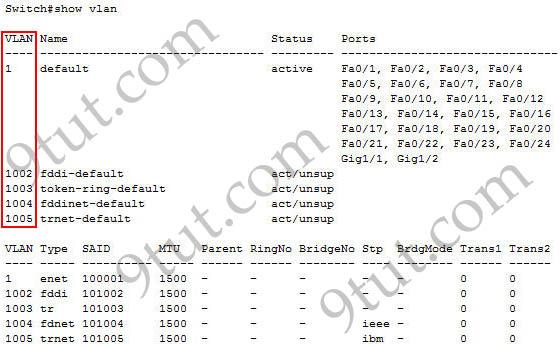
CCNA Inter VLAN Questions
Question 1
Refer to the exhibit:

Which two statements are true about interVLAN routing in the topology that is shown in the exhibit? (Choose two)
A. Host E and host F use the same IP gateway address. B. Routed and Switch2 should be connected via a crossover cable. C. Router1 will not play a role in communications between host A and host D. D. The FastEthernet 0/0 interface on Router1 must be configured with subinterfaces. E. Router1 needs more LAN interfaces to accommodate the VLANs that are shown in the exhibit. F. The FastEthernet 0/0 interface on Router1 and Switch2 trunk ports must be configured using the same encapsulation type.
Answer: D F
CCNA Subnetting
Question 1
Refer to the exhibit. Which subnet mask will place all hosts on Network B in the same subnet with the least amount of wasted addresses?

A. 255.255.255.0 B. 255.255.254.0 C. 255.255.252.0 D. 255.255.248.0
Answer: B
Explanation
310 hosts < 512 = 29 -> We need a subnet mask of 9 bits 0 -> 1111 1111.1111 1111.1111 1110.0000 0000 -> 255.255.254.0
Question 2
Refer to the exhibit. All of the routers in the network are configured with the ip subnet-zero command. Which network addresses should be used for Link A and Network A? (Choose two)
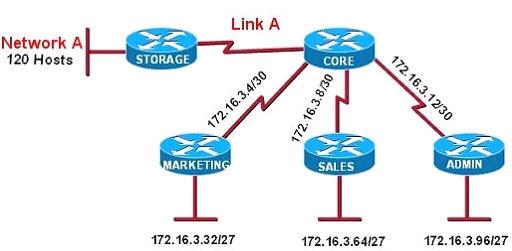
A. Network A – 172.16.3.48/26 B. Network A – 172.16.3.128/25 C. Network A – 172.16.3.192/26 D. Link A – 172.16.3.0/30 E. Link A – 172.16.3.40/30 F. Link A – 172.16.3.112/30
Answer: B D
Explanation
Network A needs 120 hosts < 128 = 27 -> Need a subnet mask of 7 bit 0s -> “/25″.
Because the ip subnet-zero command is used, network 172.16.3.0/30 can be used.
Answer E “Link A – 172.16.3.40/30″ is not correct because this subnet belongs to MARKETING subnet (172.16.3.32/27). Answer F “Link A – 172.16.3.112/30″ is not correct because this subnet belongs to ADMIN subnet (172.16.3.96/27).
Question 3
You have been asked to come up with a subnet mask that will allow all three web servers to be on the same network while providing the maximum number of subnets. Which network address and subnet mask meet this requirement?
A. 192.168.252.0 255.255.255.252 B. 192.168.252.8 255.255.255.248 C. 192.168.252.8 255.255.255.252 D. 192.168.252.16 255.255.255.240 E. 192.168.252.16 255.255.255.252
Answer: B
Question 4
Which subnet mask would be appropriate for a network address range to be subnetted for up to eight LANs, with each LAN containing 5 to 26 hosts?
A. 0.0.0.240 B. 255.255.255.252 C. 255.255.255.0 D. 255.255.255.224 E. 255.255.255.240
Answer: D
Question 5
An administrator must assign static IP addresses to the servers in a network. For network 192.168.20.24/29, the router is assigned the first usable host address while the sales server is given the last usable host address. Which of the following should be entered into the IP properties box for the sales server?
A. IP address: 192.168.20.14 Subnet Mask: 255.255.255.248 Default Gateway: 192.168.20.9
B. IP address: 192.168.20.254 Subnet Mask: 255.255.255.0 Default Gateway: 192.168.20.1
C. IP address: 192.168.20.30 Subnet Mask: 255.255.255.248 Default Gateway: 192.168.20.25
D. IP address: 192.168.20.30 Subnet Mask: 255.255.255.240 Default Gateway: 192.168.20.17
E. IP address: 192.168.20.30 Subnet Mask: 255.255.255.240 Default Gateway: 192.168.20.25
Answer: C
Question 6
Refer to the exhibit. In this VLSM addressing scheme, what summary address would be sent from router A?
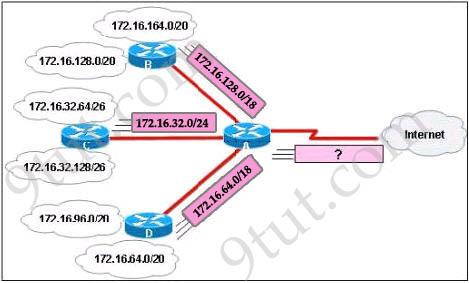
A. 172.16.0.0/16 B. 172.16.0.0/20 C. 172.16.0.0/24 D. 172.32.0.0/16 E. 172.32.0.0/17 F. 172.64.0.0/16
Answer: A
Explanation
Router A receives 3 subnets: 172.16.64.0/18, 172.16.32.0/24 and 172.16.128.0/18.
All these 3 subnets have the same form of 172.16.x.x so our summarized subnet must be also in that form -> Only A, B or C is correct.
The smallest subnet mask of these 3 subnets is /18 so our summarized subnet must also have its subnet mask equal or smaller than /18.
-> Only answer A has these 2 conditions -> A is correct.
Question 7
You are working in a data center environment and are assigned the address range 10.188.31.0/23. You are asked to develop an IP addressing plan to allow the maximum number of subnets with as many as 30 hosts each.Which IP address range meets these requirements?
A. 10.188.31.0/27 B. 10.188.31.0/26 C. 10.188.31.0/29 D. 10.188.31.0/28 E. 10.188.31.0/25
Answer: A
Explanation
Each subnet has 30 hosts < 32 = 25 so we need a subnet mask which has at least 5 bit 0s -> /27. Also the question requires the maximum number of subnets (which minimum the number of hosts-per-subnet) so /27 is the best choice -> A is correct.
Question 8
Which two benefits are provided by using a hierarchical addressing network addressing scheme? (Choose two)
A. reduces routing table entries B. auto-negotiation of media rates C. efficient utilization of MAC addresses D. dedicated communications between devices E. ease of management and troubleshooting
Answer: A E
Question 9
The network administrator is asked to configure 113 point-to-point links. Which IP addressing scheme best defines the address range and subnet mask that meet the requirement and waste the fewest subnet and host addresses?
A. 10.10.0.0/18 subnetted with mask 255.255.255.252 B. 10.10.0.0/25 subnetted with mask 255.255.255.252 C. 10.10.0.0/24 subnetted with mask 255.255.255.252 D. 10.10.0.0/23 subnetted with mask 255.255.255.252 E. 10.10.0.0/16 subnetted with mask 255.255.255.252
Answer: D
Explanation
We need 113 point-to-point links which equal to 113 sub-networks < 128 so we need to borrow 7 bits (because 2^7 = 128).
The network used for point-to-point connection should be /30. So our initial network should be 30 – 7 = 23.
So 10.10.0.0/23 is the correct answer.
You can understand it more clearly when writing it in binary form:
/23 = 1111 1111.1111 1110.0000 0000 /30 = 1111 1111.1111 1111.1111 1100 (borrow 7 bits)
Question 10
Given an IP address 172.16.28.252 with a subnet mask of 255.255.240.0, what is the correct network address?
A. 172.16.16.0 B. 172.16.24.0 C. 172.16.0.0 D. 172.16.28.0
Answer: A
Explanation
Increment: 16 (of the third octet) Network address: 172.16.16.0
-> A is correct.
CCNA Subnetting 2
Question 1
Refer to the exhibit. A new subnet with 60 hosts has been added to the network. Which subnet address should this network use to provide enough usable addresses while wasting the fewest addresses?

A. 192.168.1.56/27 B. 192.168.1.64/26 C. 192.168.1.64/27 D. 192.168.1.56/26
Answer: B
Explanation
60 hosts < 64 = 26 -> we need a subnet mask of at least 6 bit 0s -> “/26″. The question requires “wasting the fewest addresses” which means we have to allow only 62 hosts-per-subnet -> B is correct.
Question 2
Refer to the exhibit. The Lakeside Company has the internetwork in the exhibit. The Administrator would like to reduce the size of the routing table to the Central Router. Which partial routing table entry in the Central router represents a route summary that represents the LANs in Phoenix but no additional subnets?
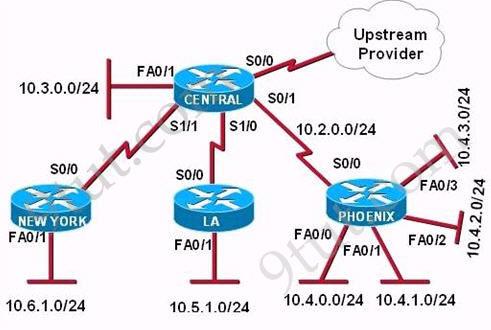
A. 10.0.0.0 /22 is subnetted, 1 subnet D 10.0.0.0 [90/20514560] via 10.2.0.2 6w0d, serial 0/1
B. 10.0.0.0 /28 is subnetted, 1 subnet D 10.2.0.0 [90/20514560] via 10.2.0.2 6w0d, serial 0/1
C. 10.0.0.0 /30 is subnetted, 1 subnet D 10.2.2.0 [90/20514560] via 10.2.0.2 6w0d, serial 0/1
D. 10.0.0.0 /22 is subnetted, 1 subnet D 10.4.0.0 [90/20514560] via 10.2.0.2 6w0d, serial 0/1
E. 10.0.0.0 /28 is subnetted, 1 subnet D 10.4.4.0 [90/20514560] via 10.2.0.2 6w0d, serial 0/1
F. 10.0.0.0 /30 is subnetted, 1 subnet D 10.4.4.4 [90/20514560] via 10.2.0.2 6w0d, serial 0/1
Answer: D
Explanation
All the above networks can be summarized to 10.0.0.0 network but the question requires to “represent the LANs in Phoenix but no additional subnets” so we must summarized to 10.4.0.0 network. The Phoenix router has 4 subnets so we need to “move left” 2 bits of “/24″-> /22 is the best choice -> D is correct.
Question 3
Refer to the exhibit. What is the most appropriate summarization for these routes?

A. 10.0.0.0/21 B. 10.0.0.0/22 C. 10.0.0.0/23 D. 10.0.0.0/24
Answer: B
Explanation
We need to summarize 4 subnets so we have to move left 2 bits (22 = 4). In this question we can guess the initial subnet mask is /24 because 10.0.0.0, 10.0.1.0, 10.0.2.0, 10.0.3.0 belong to different networks. So “/24″ moves left 2 bits -> /22.
Question 4
A national retail chain needs to design an IP addressing scheme to support a nationwide network. The company needs a minimum of 300 sub-networks and a maximum of 50 host addresses per subnet. Working with only one Class B address, which of the following subnet masks will support an appropriate addressing scheme? (Choose two)
A. 255.255.255.0 B. 255.255.255.128 C. 255.255.252.0 D. 255.255.255.224 E. 255.255.255.192 F. 255.255.248.0
Answer: B E
Explanation
We need to remember the default subnet mask of class B is 255.255.0.0. Next, the company requires a minimum of 300 sub-networks so we have to use at least 512 sub-networks (because 512 is the minimum power of 2 and greater than 300). Therefore we need to get 9 bits for network mask (29=512), leaving 7 bits for hosts which is 27= 128 > 50 hosts per subnet.This scheme satisfies the requirement -> B is correct.

We can increase the sub-networks to 1024 ( 1024 = 210), leaving 6 bits for hosts that is 26= 64 > 50 hosts. This scheme satisfies the requirement, too -> E is correct.

Notice: The question asks “The company needs a minimum of 300 sub-networks and a maximum of 50 host addresses per subnet” but this is a typo, you should understand it as “”The company needs a minimum of 300 sub-networks and a minimum of 50 host addresses per subnet”.
Question 5
Which address range efficiently summarizes the routing table of the addresses for router main?
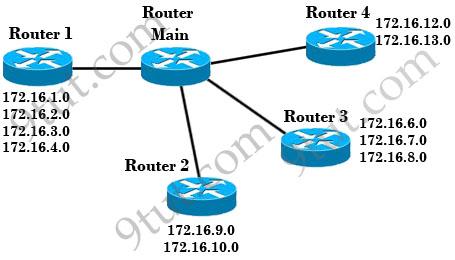
A. 172.16.0.0/18 B. 172.16.0.0/16 C. 172.16.0.0/20 D. 172.16.0.0/21
Answer: C
Explanation
To summarize these networks efficiently we need to find out a network that “covers” from 172.16.1.0 -> 172.16.13.0 (including 13 networks < 16). So we need to use 4 bits (24 = 16). Notice that we have to move the borrowed bits to the left (not right) because we are summarizing.
The network 172.16.0.0 belongs to class B with a default subnet mask of /16 but in this case it has been subnetted with a subnet mask of /24 (we can guess because 172.16.1.0, 172.16.2.0, 172.16.3.0… are different networks).
Therefore “move 4 bits to the left” of “/24″ will give us “/20″ -> C is the correct answer.
Question 6
Refer to the diagram. All hosts have connectivity with one another. Which statements describe the addressing scheme that is in use in the network? (Choose three)
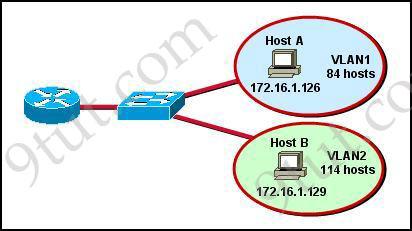
A. The subnet mask in use is 255.255.255.192. B. The subnet mask in use is 255.255.255.128. C. The IP address 172.16.1.25 can be assigned to hosts in VLAN1 D. The IP address 172.16.1.205 can be assigned to hosts in VLAN1 E. The LAN interface of the router is configured with one IP address. F. The LAN interface of the router is configured with multiple IP addresses.
Answer: B C F
Explanation
First we should notice that different VLANs must use different sub-networks. In this case Host A (172.16.1.126) and Host B (172.16.1.129) are in different VLANs and must use different sub-networks. Therefore the subnet mask in use here should be 255.255.255.128. In particular, it is 172.16.1.0/25 with 2 sub-networks:
+ Sub-network 1: 172.16.1.0 -> 172.16.1.127 (assigned to VLAN 1) + Sub-network 2: 172.16.1.128 -> 172.16.1.255 (assigned to VLAN 2)
-> B is correct.
The IP address 172.16.1.25, which is in the same sub-network with host A so it can be assigned to VLAN 1 -> C is correct.
To make different VLANs communicate with each other we can configure sub-interfaces (with a different IP address on each interface) on the LAN interface of the router -> F is correct.
Question 7
The network administrator needs to address seven LANs. RIP version 1 is the only routing protocol in use on the network and subnet 0 is not being used. What is the maximum number of usable IP addresses that can be supported on each LAN if the organization is using one class C address block?
A. 6 B. 8 C. 14 D. 16 E. 30 F. 32
Answer: E
Explanation
“The network administrator needs to address seven LANs” means we have 7 subnets < 8 = 23, so we need to borrow 3 bits from the host part (to create 8 subnets). We are using class C address block which has 8 bits 0 (the default subnet mask of class C is 255.255.255.0), so the number of bit 0 left is 8 – 3 = 5. Therefore the hosts per subnet will be 25 – 2 = 30 -> E is correct.
Question 8
Refer to the exhibit. What is the most efficient summarization that R1 can use to advertise its networks to R2?
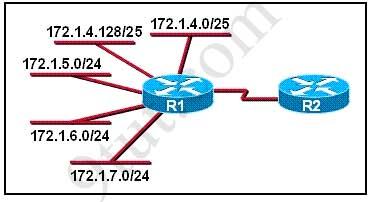
A. 172.1.0.0/22
B. 172.1.0.0/21
C. 172.1.4.0/22
D. 172.1.4.0/24 172.1.5.0/24 172.1.6.0/24 172.1.7.0/24
E. 172.1.4.0/25 172.1.4.128/25 172.1.5.0/24 172.1.6.0/24 172.1.7.0/24
Answer: C
Explanation
Network 172.1.4.0/25 and network 172.1.4.128/25 can be grouped to a single network 172.1.4.0/24
Network 172.1.4.0/24 + Network 172.1.5.0/24 + Network 172.1.6.0/24 + Network 172.1.7.0/24 can be grouped to a single network 172.1.4.0/22 because we have all 4 subnetworks so we can move left 2 bits (22=4).
Question 9
|
Gateway of last resort is not set 192.168.25.0/30 is subnetted, 4 subnets D 192.168.25.20 [90/2681856] via 192.168.15.5, 00:00:10, Serial0/1 D 192.168.25.16 [90/1823638] via 192.168.15.5, 00:00:50, Serial0/1 D 192.168.25.24 [90/3837233] via 192.168.15.5, 00:05:23, Serial0/1 D 192.168.25.28 [90/8127323] via 192.168.15.5, 00:06:45, Serial0/1 C 192.168.15.4/30 is directly connected, Serial0/1 C 192.168.2.0/24 is directly connected, FastEthernet0/0 |
Which address and mask combination a summary of the routes learned by EIGRP?
A. 192.168.25.0 255.255.255.240 B. 192.168.25.16 255.255.255.252 C. 192.168.25.0 255.255.255.252 D. 192.168.25.28 255.255.255.240 E. 192.168.25.16 255.255.255.240 F. 192.168.25.28 255.255.255.240
Answer: E
Explanation
We have 4 routes learned by EIGRP:
D 192.168.25.20 [90/2681856] via 192.168.15.5, 00:00:10, Serial0/1 D 192.168.25.16 [90/1823638] via 192.168.15.5, 00:00:50, Serial0/1 D 192.168.25.24 [90/3837233] via 192.168.15.5, 00:05:23, Serial0/1 D 192.168.25.28 [90/8127323] via 192.168.15.5, 00:06:45, Serial0/1
These subnets are all /30 (as it says “192.168.25.0/30 is subnetted, 4 subnets”. We have 4 successive subnets = 22 so we can go back 2 bits -> the summarized subnet mask is 30 – 2 = 28 and the summarized network is 192.168.25.16.
CCNA Frame Relay
Question 1
The output of the show frame-relay pvc command shows ”PVC STATUS=INACTIVE”. What does this mean?
A. The PVC is configured correctly and is operating normally,but no data packets have been detected for more than five minutes. B. The PVC is configured correctly, is operating normally and is no longer actively seeking the address the remote route. C. The PVC is configured correctly, is operating normally and is waiting for interesting to trigger a call to the remote router. D. The PVC is configured correctly on the local switch, but there is a problem on the remote end of the PVC. E. The PVC is not configured on the switch.
Answer: D
